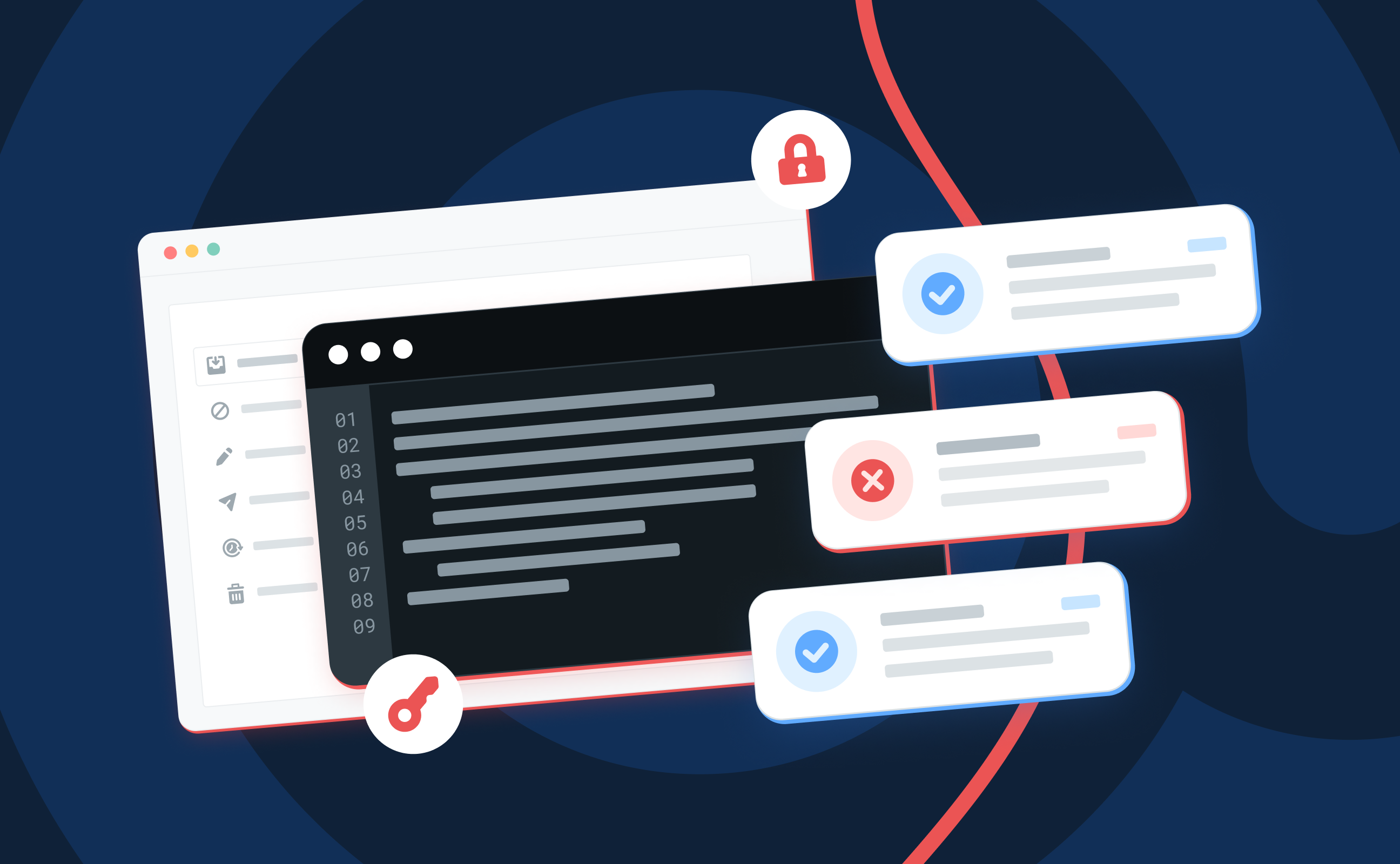Chapter 5
Email sender reputation
A clear picture of how mailbox providers view your email program helps clear the path to the inbox. But how well do you understand your email sender reputation? Find out where to focus your efforts and which tools offer the best insights.

Share to
State of email deliverability 2025
The year of Yahoogle
Email authentication in 2025
Understanding inbox placement
Email list building and hygiene
Email sender reputation
Key findings on email sender reputation
What’s your sender reputation score?
IP reputation and domain reputation
How to improve email sender reputation
How to improve email deliverability
About this survey
PUBLISHED ON
Mailbox providers are judging you – sizing you up as a sender and deciding if your emails are inbox worthy or deserve to end up in spam. Your goal is to stay on their good side, which means thinking about your email sender reputation.
Sender reputation is often compared to a credit score. Mailbox providers like Gmail and Outlook pay attention to your sending practices and use sophisticated algorithms to assess your reputation. Are you trustworthy? Are your messages anticipated and important? Or would “junk” be an accurate way to describe what’s being sent?
Key findings on email sender reputation
.%
of senders believe they have a strong understanding of their sender reputation with mailbox providers.
%
of senders are not using services like Google Postmaster Tools to monitor their reputation.
%
of senders are unsure of how to describe their email sending infrastructure.
%
of senders with the highest monthly send volumes separate transactional and promotional email traffic on subdomains.
What’s your sender reputation score?
Your email sender reputation includes these factors:
IP and domain reputation
Email authentication practices
Sending patterns/consistency
Positive and negative subscriber activities
List quality
And more...
While senders may have knowledge of these things individually, mailbox providers have their own ways of compiling multiple factors into a unique sender reputation score. Unlike a credit score, however, you won’t be able to see your exact number with Gmail, Yahoo, or Outlook.
When we asked senders to rate their understanding of sender reputation on a scale of 0 to 10, 25.5% claimed to have a high understanding (8 to 10). More than 42% of senders rated their understanding of sender reputation in the middle (4 to 7) and 32% rated it low (0 to 3).
Using a scale of 0 - 10, rate how well you understand your sender reputation with services like Gmail, Outlook, and Yahoo.
Since multiple factors contribute to your reputation, and individual providers have their own algorithms for scoring, it’s easy to see why an accurate assessment is tough to come by. High volume senders were the most likely to rate their understanding of sender reputation as strong. That could be because they’ve identified the right tools to help.
While Gmail, Outlook, and others may not publish sender reputation scores, there are services that help you keep track of the factors that influence them. That includes Google Postmaster Tools for the Gmail ecosystem, Microsoft SNDS for Outlook, and the Yahoo Sender Hub.
However, when we asked senders in our survey if they use these services, adoption was quite low. Nearly 70% of respondents are not using any of the three services from major mailbox providers to monitor sender reputation. The most used was Google Postmaster Tools at 28%.
Which of the following services do you use to monitor your sender reputation?
Use of these services is much more common among the highest volume senders. More than 63% of those sending over one million emails per month use Postmaster Tools while nearly one-third use Microsoft SNDS. Just over 11% of the largest senders use Yahoo’s service, which is newer in comparison and is adding features for senders.
A key feature each of these services offers is a complaint feedback loop (CFL). This is a system that notifies senders when recipients mark emails as spam. The notifications contain specific information about complaints so the sender can address the situation. That could mean removing addresses that complain, adjusting sending frequency, or changing email content.
Postmaster Tools and SNDS also offer information on IP and domain reputation as well as email authentication, delivery errors, and more.

Email deliverability tool
Uncover sender reputation insights
Mailgun Optimize offers integrations with both Google Postmaster Tools and Microsoft SNDS so senders can easily monitor their reputations. The platform also provides an email health score based on five critical signals that contribute to your reputation, giving you a snapshot of overall email deliverability.
IP reputation and domain reputation
The foundation of sender reputation involves your sending domains and the IP addresses from which emails are sent. So, decisions concerning your email sending infrastructure can impact deliverability.
In general, your domain reputation reflects the history of your organization’s digital trustworthiness. In a way, it’s connected to brand reputation. Your IP reputation reflects recent sending practices, and it may be shared with others on the same sending IP.
Email sending IPs
Emails can be sent from either dedicated or shared IP addresses. The reputation of a dedicated IP belongs to just one sender. On a shared IP, the behavior of other senders using the same IP address could impact your deliverability. That’s why it’s important to choose an email service provider (ESP) that closely monitors who is using the platform.
For example, Sinch Mailgun’s Acceptable Use Policy (AUP) is designed to keep senders responsible. First, certain types of senders and email content are prohibited. Sinch Mailgun users must also stay below defined thresholds for bounce rates, spam complaints, unsubscribes, and blocks. That’s what protects legitimate senders on our shared IPs from being impacted by bad actors. Everyone strives for a good sender reputation.
Our survey shows cloud-based email infrastructure solutions are most common, with a combined 52% of all respondents saying they use cloud-based email infrastructure. Only 5% of respondents said they use on-premises infrastructure and 9% have a hybrid solution.
Cloud-based email infrastructure solutions typically offer both dedicated and shared IPs. Nearly 30% of them have a shared IP while 22% are using a dedicated IP.
Which of the following best describes your email sending infrastructure?
Nearly 31% of senders were unsure of their email infrastructure while just under 5% have it on premises and 9% use a hybrid solution.
A dedicated IP is more common among high volume email senders, and our survey shows that. 45% of respondents with volumes greater than one million emails per month have a dedicated IP compared to just 15% of those sending fewer than 50,000 emails per month.
Sinch Mailgun recommends a minimum volume of 100,000 emails per month for dedicated IPs. For many senders, a shared IP will work just fine. Find out more about the differences between dedicated and shared IPs for email sending.
Email sending domains
When a sender has deliverability issues with an IP, switching to a new one can sometimes be a solution. Although, if bad habits continue on the new IP, their bad reputation will quickly catch up with them. Domain reputation follows you wherever you go.
Domain reputation is based on the history of a sending domain’s trustworthiness. Some factors connected to domain reputation you can control, such as the DNS records used for email authentication. Others, such as the age of your domain, are out of your control.
An effective way to use domains to support inbox placement is to separate your mail streams. This is often done by sending promotional and transactional emails from different subdomains.
For example, email campaigns and newsletters come from marketing.yourcompany.com while transactional messages are sent from orders.yourcompany.com. Transactional emails are much less likely to be marked as spam since they are expected and highly relevant. It’s also important that transactional messages avoid the spam folder as they usually contain timely information recipients want and expect.
If all your emails came from the root domain and people started marking promotions as spam, that could negatively impact deliverability of transactional messages. Using different subdomains for promotional and transactional emails helps distinguish different domain reputation for those mail streams.
Find out more about domain reputation and when to use an email subdomain to help you establish email infrastructure that’s optimized for inbox placement.
Sinch Mailgun research found the practice of using separate subdomains for email sending is fairly common, especially among higher volume senders. Nearly 50% of senders with volumes greater than 50,000 emails per month are separating marketing and transactional messages on different subdomains. However, 30% of the lowest volume senders also implement this practice.
Do you use subdomains to separate transactional and promotional email traffic?
The strategy of using subdomains for email sending can extend beyond just marketing campaigns and transactional messages. Many organizations also have unique subdomains for sending emails from sales, customer service, event registration, and more.
New domains and sending IPs may initially be viewed as suspicious and need to establish a good reputation. This is done by slowly ramping up send volumes while keeping a close eye on subscriber engagement and complaints. Learn more about domain and IP warmups for deliverability.
How to improve email sender reputation
Beyond the reputation of domains and IPs, what can you do to send the right signals to mailbox providers? There are plenty of different levers you can pull to make sure your email program is viewed positively. We asked senders to choose three they believe are best for improving sender reputation.
The most popular answer was Improving list hygiene (34.5%). That’s followed by Reducing spam complaints (28.3%) in the second spot while more than 26% each chose Reducing bounce rates and Strengthening email authentication.
What are the best ways to improve/repair your sender reputation with mailbox providers? (Respondents selected up to three)
Selections were spread widely among the options. The truth is, all these efforts can improve sender reputation or help you avoid problems that could damage it. What works best will depend on your email program’s current state and where there’s room for improvement.
It’s good to know why certain activities support your email sender reputation. For example, the idea of avoiding spammy language is a bit of a deliverability myth. Putting the word “free” in a subject line or occasionally using ALL CAPS probably won’t get you filtered into junk folders.
This may have been true in the past. However, modern spam filters are much better at identifying spam using other factors. It may be hard to compose copy for certain campaigns without using so-called “spam trigger words.” Plus, these days, phishing scams are just as likely to spoof transactional emails such as shipping delays or other notifications.
A better reason to avoid using spammy language in emails is because recipients, not mailbox providers, may feel like you’re spamming them. That can prompt them to mark an email as spam, and a high spam complaint rate will hurt deliverability.
If you’re focused on spammy language but you still haven’t implemented DMARC, you need to get your email deliverability priorities straight. Mailbox providers are much more likely to filter unauthenticated email into spam. Find out how to set up DMARC in five steps.
Email engagement and sender reputation
When we asked senders about the best ways to improve their reputation in 2023, email engagement was the top answer. While more than 25% chose Increasing engagement in our 2023 report, less than 15% did so this time.
On the other hand, we saw spikes in perceived importance for other factors that can impact email sender reputation and deliverability. For example, only 1.6% of respondents chose Making it easier to unsubscribe in 2023, but 20.6% chose it in our most recent survey.
.%
Senders who selected Increased engagement in 2023.
.%
Senders who selected Increased engagement in 2024.
.%
Senders who selected Making it easy to unsubscribe in 2023.
.%
Senders who selected Making it easy to unsubscribe in 2024.
The impact of new sender requirements from Google and Yahoo in 2024 may explain these year-over-year differences. The changes brought awareness to email authentication, spam complaint rates, and an easy one-click unsubscribe process.
While it’s good to see more attention in these areas, senders shouldn’t lose sight of the importance of email engagement and how it relates to sender reputation. Engagement is a measurable factor you can work to continuously improve, especially through email marketing efforts.
The more that people open, read, click, respond to, and forward your messages, the more apparent it is to mailbox providers that your campaigns belong in the inbox. On the other hand, if your emails are being ignored, deleted, or people are unsubscribing in droves, mailbox providers will assume you belong in the junk folder.
12.8% of senders chose personalization and segmentation as a tactic to improve their sender reputation score. 5.8% picked A/B testing. Even though these options landed lower on the list, they can also help you improve your engagement metrics to boost sender reputation. Segmentation and personalization lead to more relevant emails, and A/B testing helps you discover what your subscribers are most likely to engage with.
In the end, it’s all connected. Cleaning up your email list to remove inactive subscribers and sending more personalized, targeted emails results in higher email engagement rates. Making it easy to unsubscribe removes people who don’t want your emails from the equation as well.
Email deliverability tool
Will your new contacts engage with email?
What if you could know whether an email account was likely to be engaged before you hit send? It sounds like magic. But that’s what engagement criteria from Mailgun Validate can do. Separate the bots and complainers from active subscribers. This exclusive feature is only available to contract customers. Contact the Sinch Mailgun team for details.
Previous Chapter
Chapter 4: Email list building and hygiene
Chapter 4
Explore chapters

Research report
State of email deliverability 2025
Learn More

Chapter 1:
The year of Yahoogle
Learn More

Chapter 2:
Email authentication in 2025
Learn More

Chapter 3:
Understanding inbox placement
Learn More

Chapter 4:
Email list building and hygiene
Learn More

Chapter 6:
How to improve email deliverability
Learn More

Chapter 7:
About this survey
Learn More


